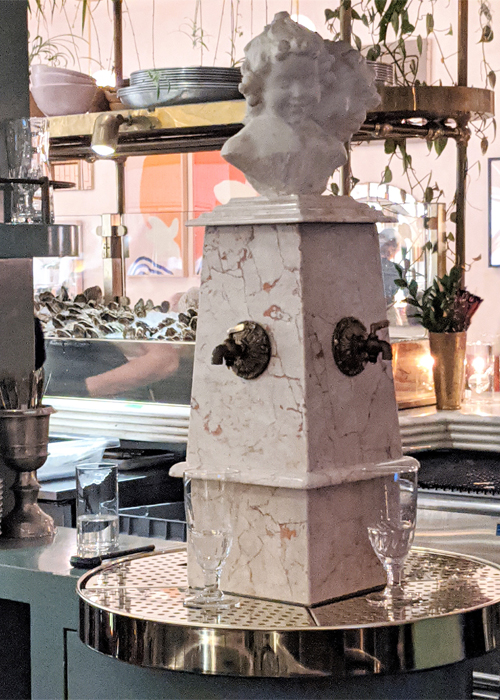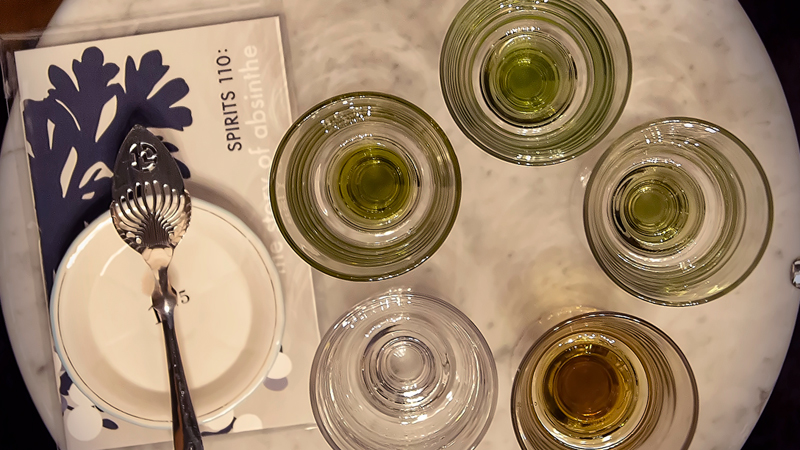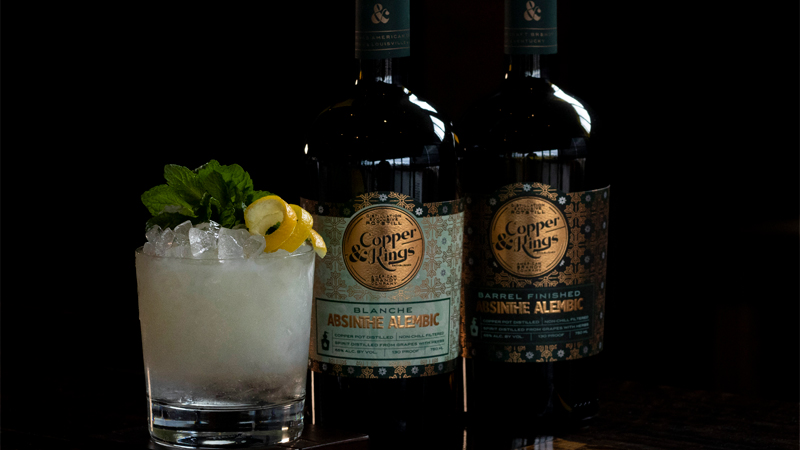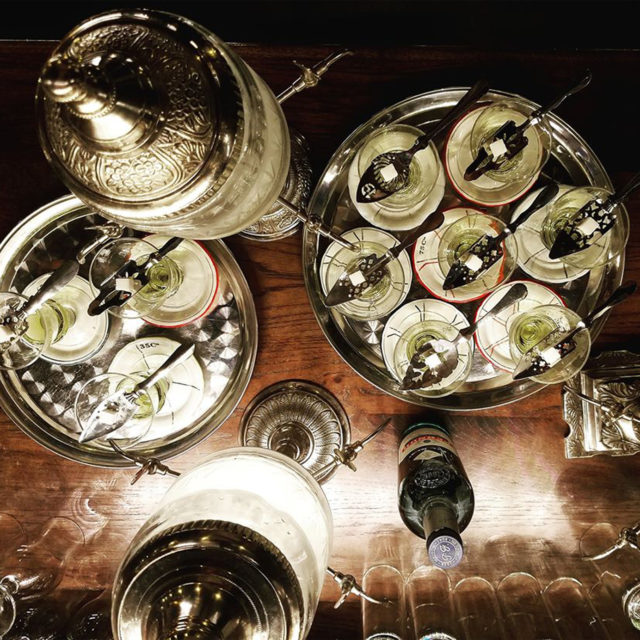Absinthe has long held a special intrigue in the minds of imbibers, and when updated regulations in 2007 effectively allowed for a large-scale reintroduction of the spirit in the United States, a surge in popularity was expected — only it didn’t really happen. Initial interest was largely tied to old myths and the mystique of a taboo, and that attention waned as quickly as it arose. In recent years, though, absinthe has made a real return, fueled by a few factors: U.S. craft distilleries producing their own renditions, a more developed cocktail scene, and bars that celebrate traditions like absinthe service, water fountains and all.
“I think the most exciting thing about absinthe right now is that it’s sloughed off the novelty tag that it had during the first few years it was reintroduced in the States,” says Brian Robinson, a spirits collector and absinthe aficionado, as well as a partner in Columbia Room, a renowned Washington, D.C., bar. “Instead, many people now view it as almost a necessity in a fully stocked bar because so many cocktails call for it, even if you’re not doing the full drip ritual.”
A Traditional Approach
That ritual, though, is at the heart of how some bars and restaurants are approaching and showcasing absinthe, allowing guests to participate in a tried-and-true tasting experience. At Jeune et Jolie in Carlsbad, Calif., beverage director Leigh Lecap offers a wide-ranging lineup of different absinthes available with traditional service, highlighted as a fundamental piece of the establishment’s identity with a cherub-adorned marble fountain in the center of the bar with piped-in, properly chilled water.

“Jeune’s cuisine is a reaction to the current trend of bistronomy in Paris and how the new guard of chefs are interpreting classic French cuisine,” Lecap explains. “We’ve embraced the Nouvelle concept of adopting global influences, obeying the seasons, celebrating locality, and paying a lot of attention to composition. In a way, we thought the bar program should mirror our kitchen’s sentiment and honor an era in France when the country as a whole experienced a renaissance in art, literature, and science, and adopted new ways of thinking and perceiving. Absinthe soaked the thread woven between all those things.”
To honor that thread, Jeune et Jolie has even instituted L’Heure Verte, or “The Green Hour,” an all-things absinthe late-night happy hour of sorts, late on Friday or Saturday nights. “With the consumer, there are always still questions of whether or not it’s real, or ‘will I hallucinate?’, which is my favorite,” Lecap says. “A couple quick facts about when the ban was lifted in the U.S. and what ingredients in the distillation make absinthe what it is, usually does the trick. Explaining absinthe is — more often than not — enlightening and incredibly enchanting. There’s nothing else like it.”
At West Main Crafting Co. in Lexington, Ky., Jonathan Laurel has put absinthe at the forefront of his offerings as well, including in cocktails and traditional fountain-style service, and offers an environment where imbibers can taste in an environment built for education and dialogue. “The average absinthe drinker — even the experienced ones — still have plenty of questions about absinthe chemistry, styles, history, and tasting,” he says.
For Laurel, West Main fills an important gap in the beverage space. The country has plenty of whiskey or agave bars, for instance, “but not yet a program like ours where you can drink an absinthe, read tasting notes, and taste individual tinctures that illustrate those notes,” he says.
Beyond an educational approach and a deep selection, using a traditional fountain was an essential part of what West Main envisioned with its absinthe offerings. “The iconic golden-age apparatus for diluting absinthe was the fountain, an artistic, elaborate silver stand with a bowl of ice water in the top and individual spouts,” he says. “We couldn’t do absinthe service without offering this pillar of the experience — it’s such a spectacle and it captures people’s imagination.”

Absinthe Made in the USA
A range of distilleries are now trying their hands at quality all-American absinthe. Philadelphia Distilling, for instance, produces Vieux Carré Absinthe Supérieure, which was initially released at the end of 2008 as the “first legal absinthe to be distilled, bottled, and sold on the East Coast of the United States” in nearly a century.
Robinson points to brands such as Delaware Phoenix, Leopold Brothers, Lawrenceville Distilling, Tenth Ward, and Mt. Defiance, as among his favorite American producers. “They’re all doing great work by integrating historical protocols and ingredients with slight twists to make them their own,” he says. “All of them are great representations of the category, and they all seem to be doing it as a labor of love, which shows in the final product.”
The Absinthe Verte from St. George Spirits is another bottle to know. The lauded distillery infuses brandy with wormwood, fennel, and star anise, distills the infusion, and then infuses again with botanicals such as mint, tarragon, hyssop, and stinging nettles. The company suggests serving its absinthe with a single ice cube and no sugar, or using it in a classic cocktail.
Some of the most widely available American absinthes come from Louisville brandy producer Copper & Kings, which produces two absinthes in its lineup, an Absinthe Blanche, as well as a barrel-aged offering. “We also have some sublime absinthe aging in port and in sherry now that is over four years old, and ridiculous,” founder Joe Heron says. He calls absinthe a “distiller’s paradise in terms of botanical engineering,” and notes that original absinthe had brandy as a base as well. “We wanted to celebrate the history and the heritage, and to showcase our own brandy distillation competence.”
As with St. George, Copper & Kings also recommends skipping the sugar cube during a traditional service. “We do not add sugar to the spirit, with the botanicals, such as fennel, licorice, anise, and black pepper (which distills sweet) all sweet enough already,” Heron says. “The sugar cube is really for spiky absinthe made with grain-neutral spirits.”

Classic Cocktails & New Riffs
At Jeune et Jolie, Lecap relishes the opportunity to showcase absinthe in a broad range of cocktails. “It’s a fun challenge to remind people of absinthe’s versatility,” he says. “It doesn’t just bury every drink that contains it. I think tiki really opens the door for the inclusion of absinthe in cocktails the way it lends itself to warm spices and tropical flavors. And even as bartenders, we forget how absinthe is used across the spectrum of drink styles, from the Sazerac and Robert Burns, to the No 2. versions of both the Tuxedo and Corpse Reviver.”
An example of that versatility is seen on Lecap’s menu, where he also offers an absinthe frappé. The refreshing serve is about as far removed on the flavor spectrum from the spirituous, bold Sazerac as possible.
“Absinthe cocktails serve as a genius gateway for people,” Laurel says. “Just as with other spirits, there’s always a way or a cocktail to make a proper introduction for every palate. Convincing someone they actually love the spirit they’ve expected to hate is rewarding.”
At Columbia Room, beverage manager Paul Taylor feeds off the curiosity of his guests and seeks to deliver an authentic experience. While the Sazerac is his personal favorite absinthe cocktail, he also recommends a French 75 riff with absinthe subbing in for gin, particularly for the first-time, absinthe-curious imbiber. “If someone is interested in getting into absinthe and enjoys the flavor, I like to make that for them,” he says. “Shake the absinthe, a rich simple syrup, and lemon juice, strain it into a white wine glass, and top with Champagne. Boom!”
This story is a part of VP Pro, our free platform and newsletter for drinks industry professionals, covering wine, beer, liquor, and beyond. Sign up for VP Pro now!
